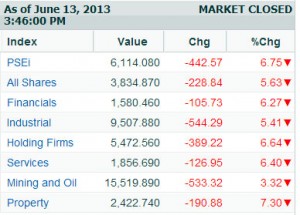PH stocks in historic fall
MANILA, Philippines—Foreign funds are pulling out of regional stock markets in anticipation of reduced monetary stimuli from major central banks, sending the local stock barometer to unprecedented freefall and wiping out most of the gains for the 2013.
The main-share Philippine Stock Exchange index bled by 442.57 points or 6.75 percent to close at 6,114.08 on Thursday. This marked the worst bloodbath seen by the local stock market in history in terms of index points although in terms of percentage, this was still less than over 7-percentage point declines seen 12 years ago at the height of the domestic political uncertainties that eventually led to the ouster of then president Joseph Estrada.
The index has now given up 1,289.57 points or 17.4 percent since hitting an intra-day peak of 7,403.65 last May 15. Since the start of the year, however, the index is still ahead of 301.35 points or around 5 percent from the end-of-2012 level.
“What’s happening now is the tide is going out and as (American investment guru) Warren Buffet says, when the tide is going out, you’ll know who’s naked,” said Jose Mari Lacson, head of research at the local stock brokerage Campos Lanuza & Co.
Effectively, Lacson said the market has been “wiping out the premium” paid for by investors for all the excess liquidity arising from the quantitative easing – or the liquidity-inducing bond buyback activities – of the US Federal Reserve.
“I know it looks really bad. I’ve never seen it that bad (in terms of single-day decline in index points), but in terms of percentage, we’ve seen worse. Neither should we be entirely concerned because there’s no change in the country’s macroeconomic fundamentals, with a 7.8-percent growth rate still the best in the region and we have record-high GIR (gross international reserves) level,” he said.
The Philippine government has also been given an investment grade rating by two major global credit watchers – Fitch Ratings and Standard & Poor’s.
Manny Cruz, chief strategist at Asiasec Equities, said foreign-managed exchange-traded funds (ETFs) were selling out in heavy volume orders since Tuesday. The PSEi lost 318.95 points or 4.64 percent on Tuesday.
“They are converting into US dollars and moving out,” Cruz said, noting that the most battered markets were those under the TIP – Thailand-Indonesia-Philippines- bloc of emerging markets as well as Japan.
The bloodbath was widespread across the region, with the Nikkei 225 falling by 6.35 percent on Thursday.
“TIP as an emerging market group spear-headed the uptrend in the region in the last three years. These markets were the best performing and so they are also now being hit by the hardest profit-taking,” Cruz said.
The local stock market, for its part, has been on an upswing in the last four years.
One key catalyst has been the announcement that the US Federal Reserve might scale back its bond-buying activities that have boosted global markets- and especially emerging markets – in recent years.
Apart from the prospective withdrawal of monetary stimulus, Cruz said there have been increasing concerns on the high valuation of equities in the regional bloc alongside increasing belief that the US dollar would get stronger versus regional currencies. In the case of the peso, the local currency has depreciated to the 43 to $1 level after trading at 41-42 levels in the last few years.
Aside from jitters over the US Fed’s policy, markets were disappointed by the lack of action from Bank of Japan. Since Tuesday, there was unwinding on short yen positions.
At the local stock market on Thursday, all counters closed in negative territory but the hardest hit was the property counter (-7.3 percent). Property is deemed as a cyclical sector that is sensitive to interest rates.
On Thursday, it was also announced that the Bangko Sentral ng Pilipinas kept its overnight policy rates and special deposit account (SDA) rates unchanged, suggesting that local interest rates might be bottoming out.
Value turnover at the local stock market was heavy at P16.1 billion. There were 10 decliners for every single gainer at the market.
The biggest index laggers were San Miguel Corp. (-11.58 percent), Bloomberry Resorts (-9.86 percent), Alliance Global Group (-8.86 percent), Jollibee Foods Corp. (-8.77 percent), Aboitiz Equity Ventures (-8.65 percent), Banco de Oro Unibank (-8.61 percent), Megaworld Corp. (-8.45 percent), SM Prime Holdings (-8.39 percent), Ayala Land Inc. (-8.33 percent) and International Container Terminal Services Inc. (-8.14 percent).
Asiasec’s Cruz said that at current levels, stock market valuations have become attractive. “I think the market is already ripe for a technical rebound in the near term, in time for semestral rally and window-dressing for end-June,” Cruz said.
At current levels, he said the market has been trading at a price-to-earnings (P/E) ratio of 18.2x projected earnings for 2013, falling from as high as 22 to 23x.
A P/E ratio of 18.2x means investors are paying 18.2 times the amount of money the market is likely to make for a given period. The historical trend for the local market has been a range of 14-15x P/E.
“But come July, there could be another sell-off. This may trigger the index to go below 6,000,” Cruz said.
Campos Lanuza’s Lacson said excluding the impact of excess liquidity, the local market would be fairly valued at 5,900 but added this would not necessarily be the bottom.
Technically, the local stock market would be considered to have shifted from a bull to a bear market if the index falls by 20 percent from the peak. But since the recent rally was induced by excess liquidity, Lacson said the reckoning point should be from the fair valuation of 5,900. “If the index falls by 20 percent from 5,900, then we’re back to a bear market but that has to be accompanied by high inflation rate and economic recession,” he said.


